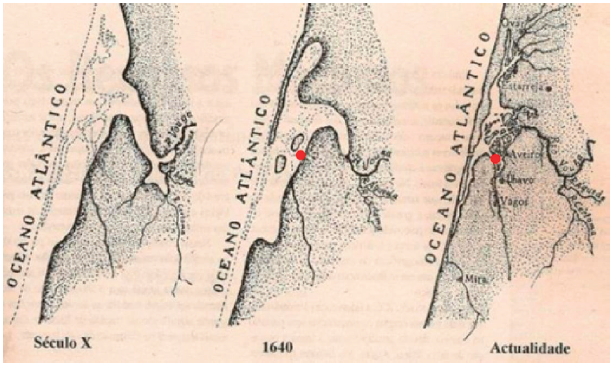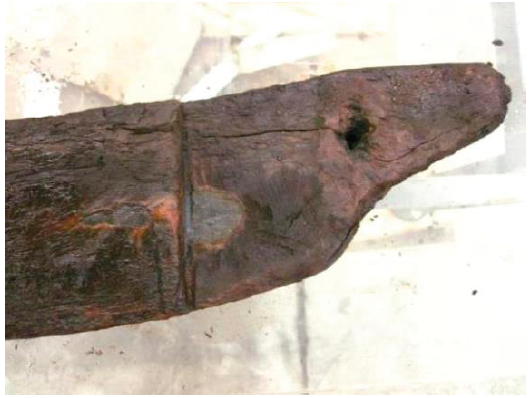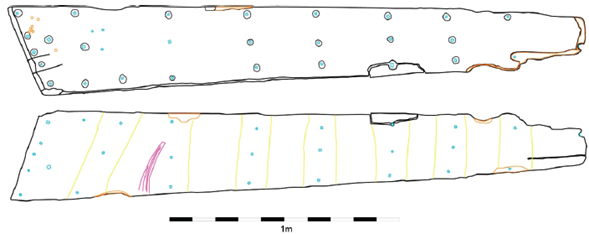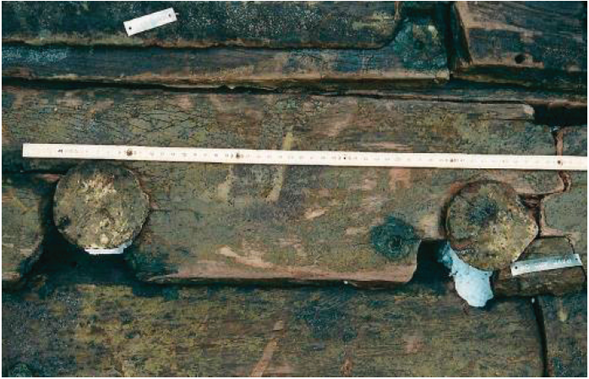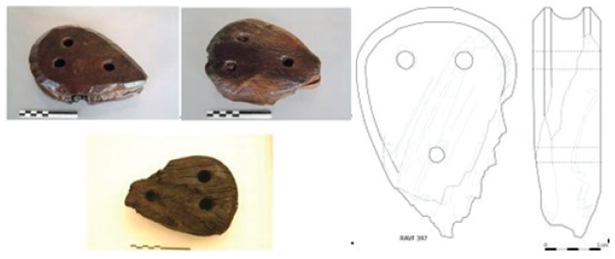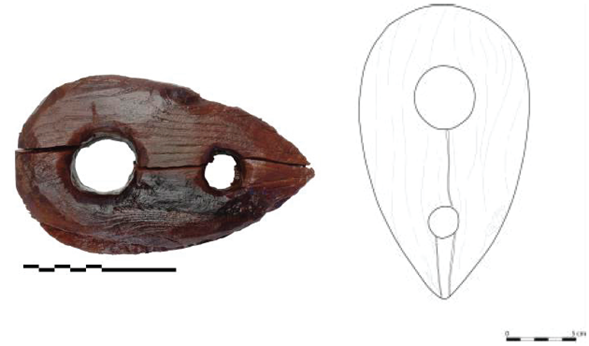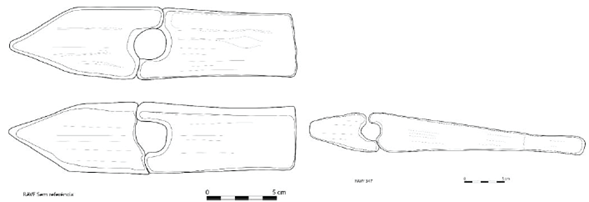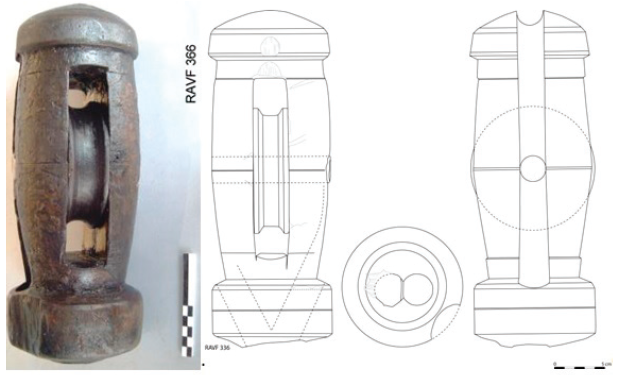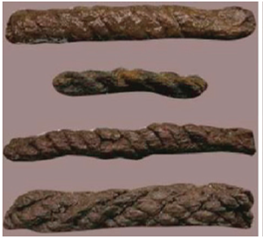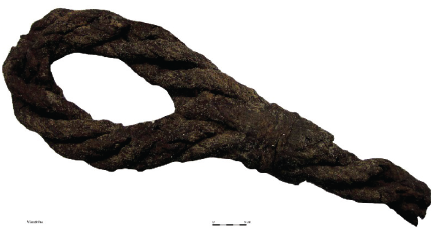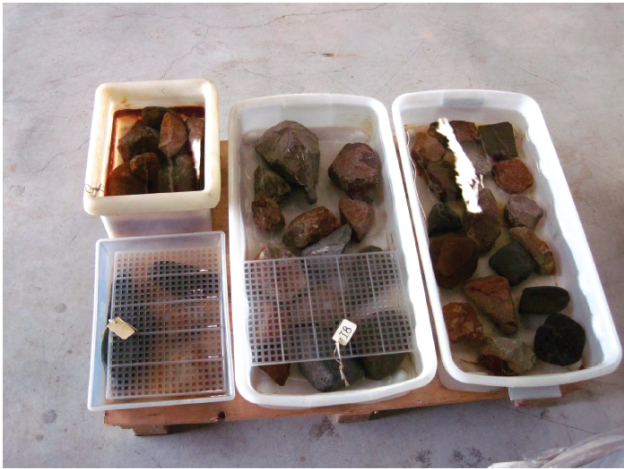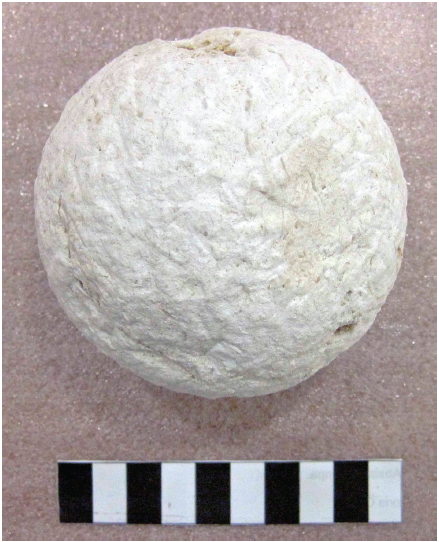Introduction
The Ria de Aveiro F (RAVF) shipwreck was discovered in February 2002, during the archaeological monitoring of the dredging works carried out in the scope of the construction of the roll-on/roll-off terminal of the port of Aveiro (Fig.1). The archaeological assessment revealed the existence of shattered and scattered wood fragments with fastening marks, over an area of approximately 40,000 m2. The radiocarbon analysis of wood samples from the ship timbers indicated a date between 1280 and 1460, which made this finding the oldest remnant of a vessel ever found in Portugal, back in 2002. (Rodrigo, 2002, p.1).
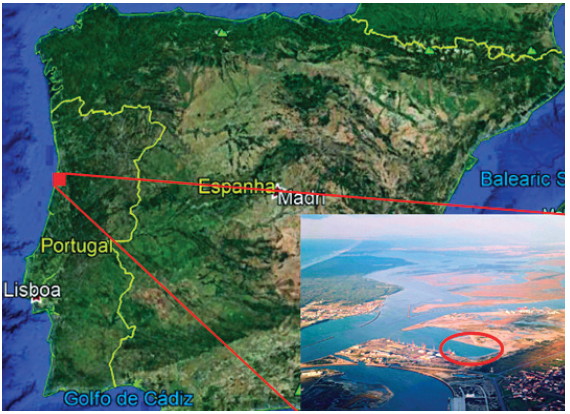
Source: Adapted from Rodrigo, 2002, p. 2.
Figure 1 Geographical location of Aveiro (Google Earth, 28 September 2018) and aerial photograph of the roll-on/roll-off terminal of the port of Aveiro, where the RAVF remains were found)
These results required the interruption of the dredging works in order to carry out emergency archaeological excavations, between February and June 2002. This task was hampered by the working conditions, namely the low depth and almost zero visibility during most of the time, due to the action of the dredger, working simultaneously in nearby areas. The excavation and recording were based on a 20x20 m georeferenced grid centred on the best preserved cluster area, which included part of a ship's stern. The intervention also included a bathymetric survey and the recovery and labelling of surface material (Rodrigo, 2002, p.2-3). Several pieces of rigging (wooden and rope artifacts) were found during the excavation, as well as pottery shards, ballast stones and a limestone cannonball.
The first studies revealed an apparent heterogeneity of the findings and the dispersion of the materials suggested the possibility of the presence of several shipwrecks, within the same chronological interval, as indicated by the C14 results, although the hypothesis of a single ship built using mixed construction techniques was not excluded (Rodrigo, 2002: 16). However, although the identified characteristics and the condition of the remains did not allow to relate the RAVF hull structures with any particular shipbuilding tradition, some features had parallels in medieval and early-modern ships of Mediterranean origin. (Bettencourt, 2009, p.152-153).
Following this hypothesis, this article will present the results of the study of the RAVF remains, developed as part of the first author's master's thesis (Lopes, 2013) and of the project titled "Arqueologia Marítima da Ria de Aveiro" ("Maritime Archaeology of the Aveiro Lagoon", headed by CHAM - Faculdade de Ciências Sociais e Humanas / Universidade Nova de Lisboa e Universidade dos Açores. This study is based on the systematization of the field documentation and on the exhaustive study of the archaeological materials.
The site
RAVF was discovered in a marshy area of the Ria de Aveiro, a lagoon system dating back to the 10th/11th century, when a sandy shoal began to form, from north to south, roughly starting from the present-day city of Ovar (Fig. 2) and completely transforming the mouth of the Vouga River, which by then flowed into a large bay (Freitas & Andrade, 1998, p.69). From the beginning of the 15th century onwards, this lagoon complex underwent significant morphodynamic changes, with the migration of the natural bar to the south, the formation and development of islands and canals and some silting up of the inner gulf, through the deposition of sediments transported by various water courses. This process became faster when the shoal reached the sands of Mira, to the south, preventing contact with the interior of the lagoon and, consequently, restricting the dynamics of direct removal by the action of waves (Bastos, 2004, p.47-51). It was during this period of morphodynamic alteration of the lagoon that RAVF arguably sunk or was abandoned.
In this context, the location of RAVF corresponds to an old navigable channel that separated the area of the present-day Gafanha da Nazaré from the island of Mó do Meio, of which only a small portion (an esteiro) remained at the time of discovery (Fig. 3). This hypothesis is confirmed by a northeast-southwest oriented depression, still visible in the 1:25 000 scale cartography (Rodrigo, 2002, p.10). The old cartography confirms this observation: in the 17th century this area featured a number of small islands crossed by several channels, to the north/northwest of the archaeological site. However, by the end of the 18th century the area was already silted up and there was a channel that surrounded the island of Mó do Meio, probably due to the silting up of the old channels (Amorim, 1997, p.102; Dias, 2004, p.168).
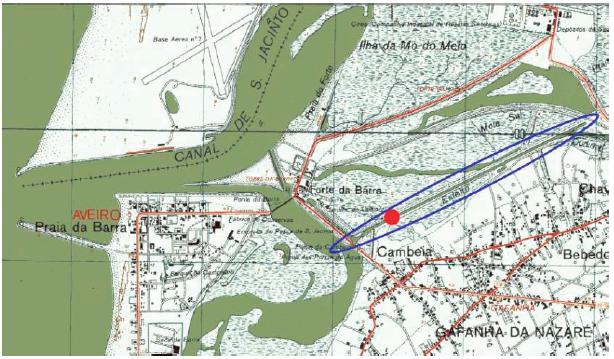
Figure 3 Military chart of Portugal, 1:25000 - excerpt from the sheet 184; location of the RAVF in red, the esteiro in blue.
The silting up of the area has probably resulted in an environment that favoured the preservation of archaeological remains. These remains were found in a layer of sand, over the gravel lying at the bottom of the canal, and under a layer of clay with organic remains, belonging to an ancient marsh, also covered by sandy sediment (Fig. 4). The harbour works resulted in a high degree of destruction of the structures, which were shattered by the dredge, and originated a north-south oriented slope with an east-west dip and with elevations ranging from 0.5 m to 2.5 m Hydrographic Zero (ZH). Several destroyed and displaced fragments of timbers were found on this slope (Rodrigo, 2002, p.5).
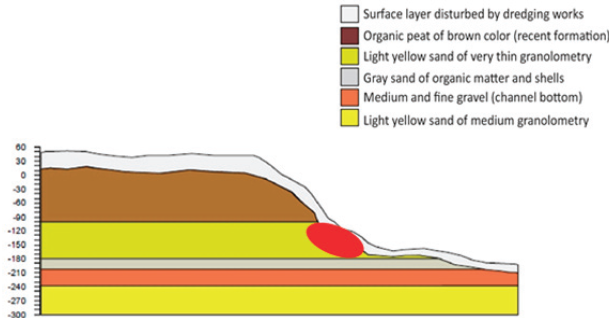
Source: adapted from Rodrigo, 2002, p. 42
Figure 4 A scheme of the stratigraphie cross section of the excavated area
Six clusters of timbers of different sizes and typologies belonging to nautical elements were found: cluster 1, corresponding to a fragment of a wooden frame with notches to fit the clinker hull; cluster 2, where a turf block, a hull plank and a vessel's futtock were recovered; cluster 3, corresponding to a mast step; cluster 4, with two fragments of nautical elements; and cluster 5, with two elements of the ship's longitudinal structure (Rodrigo, 2002, p.10). The two main nautical structures still in connection, composed of about 250 timbers, were found close to clusters 3 and 4; this was the area where the archaeological excavation took place (Fig. 5).
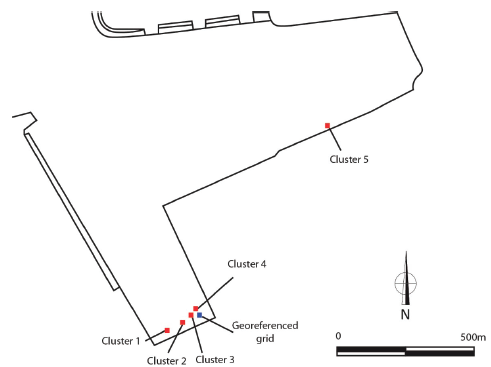
Source: adapted from Rodrigo, 2002, p.45.
Figure 5 Location of the secondary clusters identified during the works carried out around the central cluster, represented in this image by the survey grid
The two nautical structures still in connection featured different orientations and their extremities were partially destroyed by the dredgers (Fig. 6). The stern portion of a carvel-built hull was found at a higher level (level 1), with a northwest-southeast orientation including the stern (stern heel), the Y shaped frames and part of the port and starboard planking; further east there were five other boards and a footwale with the same orientation as the stern, but not physically connected to it. The lower level (level 2), with a northeast-southwest orientation, was composed of a centraland better preserved zone located immediately under the stern found in level 1, and two clusters of smaller timbers, located south of the former area. This set of remains corresponded to the gunwale of a small clinker-built vessel (Rodrigo, 2002, p.5-7).
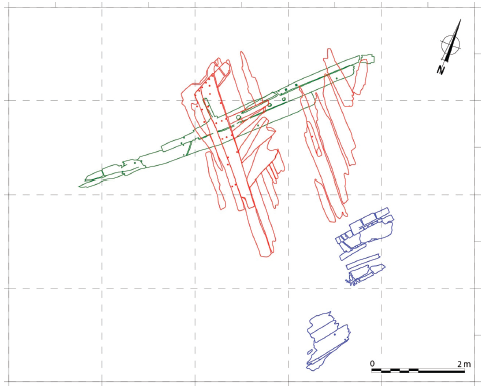
Source: Adapted from Bettencourt, 2009, p.150.
Figure 6 Overall plan of the excavation; in red, the carvel-built hull; in green, the central zone of the clinker-built hull (level 2); in blue, the smaller agglomerations (level 2)
The structure of the carvel-built hull
The main nautical structure corresponded to the northwest-oriented stern of a ship, resting on its port side and preserved in a maximum extension of 3.80 m. Although partially destroyed by the dredger, it preserved the stern, four Y-shaped frames, four outer planking boards on the port side and two more on the starboard side. On the port side, besides the planking attached to the Y-shaped frames and to the stern, there was also a set of five other planking boards, still in connection, and a footwale, but in discontinuity with the main structure; their extremities were also destroyed by the dredge (Fig.6). Most of the very small and shattered elements that were found in the periphery were part of this structure.
As no fragment of the keel was found, the only evidence of the ship's longitudinal structure is the incomplete stern (Fig. 7), measuring 1.59 m in length. It was 21 cm sided by 11.5 cm moulded in the extension of the keel and 34 cm sided by 13.5 cm moulded at the beginning of the sternpost.
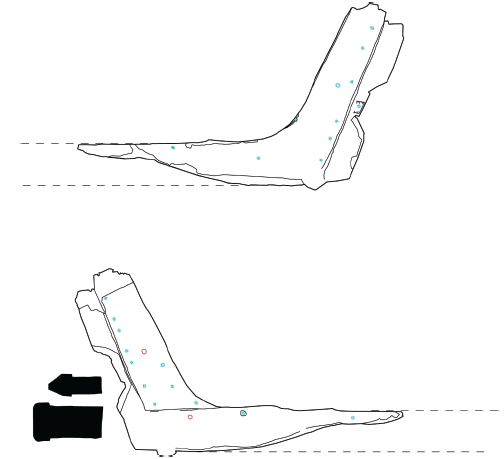
Source: Adapted from the originals of CNANS archives.
Figure 7 Sternpost - views from port, starboard, sections and a projection of the keel's developing
At the top there was a partially preserved flat scarf, 13.5 cm wide and 5.5 cm deep, which ensured the connection to the sternpost (not preserved). On the aft side there was a notch 43 cm high, with a slight depression on the port side, perhaps to fit an axial rudder gudgeon;. This notch was intended to bring the rudder gudgeons closer to the stern, since the former is attached to the ship's structure itself, functioning as a hinge. The aft face was convex and faceted, so that its extremity was smaller than the maximum width of the couch, thus increasing the rudder amplitude.
Along the entire piece, on both sides, there was a ca. 1.5 cm deep rabbet, which served to house the planking hoods, close to the keel, and of the extremities of the boards and the stern. Both sides of the stern were covered with traces of a yellowish waterproofing material, possibly gála-gála (a mixture of fish oil and chalk used for the protection of the hull, known in Portugal at least since the 16th century), which formed the negatives of the hull planks, thus attesting to their attachment.
There are no clear morphological parallels to the RAVF stern, although the transition between the keel and the sternpost using a single element is a common feature on Iberian ships, such as Studland Bay wreck (England, early 16th century) (Oertling, 2001, p. 236), San Esteban (USA, 1554), San Juan (Canada, 1565), Ria de Aveiro A - RAVA (Portugal, second half of the 16th century / early 17th century) (Carvalho & Bettencourt, 2012, p.742-743) and Boa Vista 1 (Portugal, mid-17th century to mid-18th century) (Bettencourt et al., 2013, p.27). However, RAVF features distinct characteristics that make it a singular case, such as the fact that the stern does not feature a heel, as opposed to what happens in the overwhelming majority of the other examples and, it does not have a stern knee to reinforce the stern/keel connection zone.
The angle of the heel is 65°. This value is identical to that of San Esteban and Western Ledge Reef wreck (Bermuda, 1577) and similar to the 63° recorded in RAVA but slightly different from the 72° of San Juan (Alves et al., 2001b, p. 30; Alves, Rieth & Rodrigues, 2001, p. 410) and the 75° of Villefranche-sur-Mer (Mediterranean France, 1516) (Chapman, 1998, p. 68).
The shipbuilding treatises of this period refer to several formulas and calculations required to obtain this angle. The Livro Náutico ou meio prático de construção de navios egalés antigas (ca. 1580) mentions that the angle of the heel must correspond to a quarter of the height of the nau or galeão. Fernando Oliveira1 (Oliveira, 1580/1991) mentions that the angle must be a quarter or a fifth of the height of the vessel (Barata, 1989, p.168-169). In turn, João Baptista Lavanha2 (Lavanha, 1608-1616/1996) indicates that the height at the sternpost should be two-fifths of the keel and its angle two-sevenths of this height. Lastly, Manuel Fernandez3 (Fernandez, 1616/1989) said that the angle should be the average between a third and a quarter of the keel, while stating that the angle of the heel should be between 65° and 80°, depending on the tonnage of the vessel. For example, the "Timbotta Manuscript" (1445) (Anderson, 1925) mentions that a ship with a capacity of 700 to 1.000 tons should have an angle of 80°; Fernando Oliveira (Oliveira, 1580/1991), refers to an angle of 78° for a 600-ton nau, while Diego García de Palacio4 (García de Palacio, 1587/1944), alludes to an angle of 70° for a ship of 400 tons and 65° for a ship of 150 tons and Manuel Fernandez (Fernandez, 1616/1989) indicates an average of some 74°. In this sense, the higher the tonnage of a vessel, the closer to 90° should the angle of the heel be (Barata, 1989, p.170).
The four Y-shaped frames found in situ were between 10 and 15 cm moulded and between 9 and 12 cm sided at the base (Fig. 8). They have a rectangular section and sit directly on the stern heel. The height and distance between the two arms of the Y-shaped frames varied according to the proximity to the extremity of the vessel - the closer to the stern the higher and narrower they would be. Thus, the height of Y-shaped frames varied between 1.20 and 1.36 m. The other, more deteriorated Y-shaped frames were between 10 and 13 cm sided at the base and between 13 and 18 cm moulded. In some cases, it was possible to identify the 4 cm high and 2.5 cm wide limber hole, located at the base of the Y-shaped frames, in the contact area on top of the heel and keel.
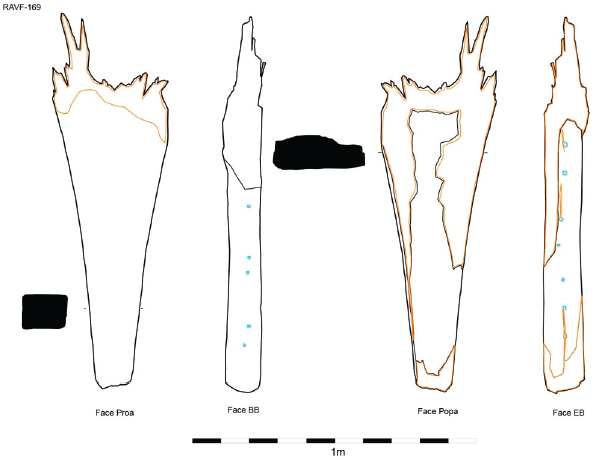
Source: Adapted from the originals of CNANS archives.
Figure 8 Drawing of the RAVF-169 Y-shaped frame found in situ
The Y-shaped frames were attached to the stern heel using iron nails, placed at an angle in countersinks on the bow or stern sides, oriented towards the keel or the stern, which can still be seen on the upper side of the latter. These iron nails were round with 2 cm in diameter, and were observed in several timbers. In one of them, in addition to the oblique fastener that joined it to the stern, there was also a vertically oriented square nail at the top, measuring 1.5 cm to the side, which penetrated 20 cm into the stern; this could have been used to attach the keelson, which goes along to the delgado. In the lateral faces, there were also holes for square nails, 1 cm to the side, used to attach the planking boards, which penetrated between 3 cm, closer to the base, and 10 cm, closer to the top, into the Y-shaped frames; in some cases, the nails perforated the timbers from side to side.
In addition to the Y-shaped frames, which were better preserved, several shattered and scattered fragments of other frames' timbers were also identified. Despite their poor condition, these fragments with small sections, between 10 and 14 cm sided and moulded, revealed several interesting details. In some cases, 1.5 cm deep hook scarves (Fig 9) were identified, joining the two ends of the frames/ futtocks. This type of joints was reinforced by three square iron nails, 1 cm to the side, two of them nailed from one of the pieces and one from the other.
These pieces can be related to a Mediterranean shipbuilding tradition (Bettencourt, 2009: 152) because they appear on ships such as Culip VI (Catalonia, mid-14th century) (Apestegui et al., 1998), Yassi Ada (Turkey, 16th century) (Chapman, 1998) and also on the Sardinaux ship (Mediterranean France, late 17th century) (Joncheray, 1988). In all examples, the scarves were ca. 1,5 to 2,5 cm deep, as in RAVF. Furthermore, there is also the almost exclusive use of iron nails as a fastening system, which besides having been used in the above referred ships, was also identified in the Calvi I shipwreck (Corsica, late 16th century) (Villié, 1994), Villefranche-sur-mer (Guérot, Rieth & Gassend, 1989) and Boa Vista 1 (Bettencourt et al., 2013).
The planking of the vessel was preserved in the area of the main structure, on two starboard boards found in connection with the stern (Fig. 10). It was also preserved on four in situ port boards, with a length of up to 2.97 m, better preserved although separated from the main cluster. Systematic analysis of all planks, mostly small fragments with lengths between 0.90 m and 1.20 m, indicates that they were between 16 and 38 cm wide and between 3 and 5 cm thick.
In the main cluster, the planks were attached to the stern heel and the frames by means of square iron nails, 1 cm to the side, there being a set of two or three nails per joint, and as many as six in the extremities. The nails had a countersink of 2.7 to 3 cm in diameter. The same pattern was identified on dispersed fragments, among which a garboard with bevels stands out. These bevels were located both at the base, where they served to fit into the keel rabbet, and at the extremity, where they allowed the sternpost to fit into the rabbet. This plank was 19 cm wide, 4 cm thick and had a preserved length of 1.10 m (Fig 11). Some of the planks that were fixed to the stern heel still had small notches to fit the rudder gudgeons (Fig. 11). The fastening of these iron fittings was reinforced by one or two square iron nails, 1 cm to the side.
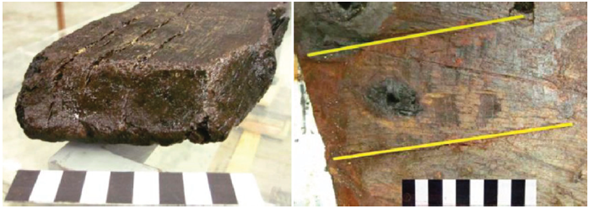
Source: Photo by Gonçalo C. Lopes.
Figure 11 Garboard showing the bevels to fit the rabbet; notch on one of the planks found in situ, to fit one of the rudder gudgeons
Several incomplete footwales were identified among the outer planking (the largest measured 1.25 m); they featured bevels along the outer edges (Bettencourt, 2009, p. 149). Their width varied between 11.5 and 16 cm and the thickness between 6.5 and 10 cm.
Thus, in spite of its poor condition and in terms of its dimensions and full metal fastenings, the RAVF planking is not dissimilar to other small/medium sized ships, such as the RAVA (Alves et al., 2001b), the Molasses Reef wreck (Turks and Caicos Islands, early 16th century) (Oertling, 1989) and the San Esteban, (Chapman, 1998, p.112). The use of gála-gála has been documented since at least the 16th century, for example in O livro da Fabrica das Naos (Oliveira, 1580/1991), as an expedient for strengthening vessels that sailed in warm waters, protecting them from the teredo navalis.
Among the pieces scattered around RAVF there was a mast step (Fig. 12), located 28 m west of the main carvel-built structure. It was very deteriorated, measuring 2.07 m in length, with a width of 41 cm and a thickness of 35 cm. The underside is notched and the notches measure between 14 and 17.5 cm wide by 28 cm long, to fit on the upper surface of the frames, pressing them against the keel, which indicates that it could be an integral part of the keelson.
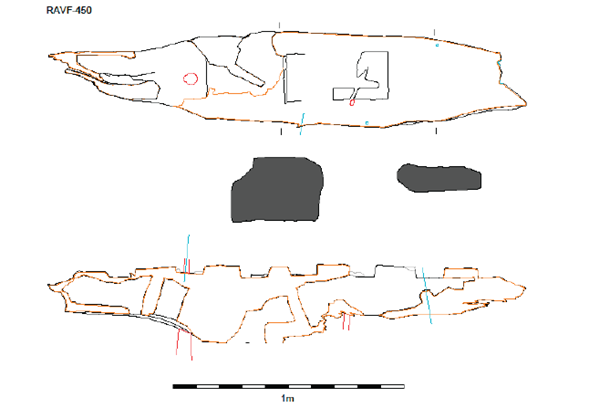
Source: Adapted from the originals of CNANS archives.
Figure 12 Mast step drawing of the upper face, one of the lateral faces and the sections, clearly notched
The mortise of the mast step had a rectangular shape and was 47 cm long, 21 cm wide and 17 cm deep. Two circular channels were identified at the bottom of the mortise, the largest of which is 2.5 cm in diameter, through which water that would seep into the bilge could be drained (Bettencourt, 2009, p.151). This detail has parallels on the Emanuel Point ship (USA, mid-16th century) (Smith, Spirek, Bratten & Scott-Ireton, 1995, p.26-28). In the centre of the mast step's mortise there was a stain of a different colour, 23 cm long and 11 cm wide, which probably results from wear caused by the mast's heel tenon that sat there.
The preserved section of the mast step was attached to the frames by means of a nail and a wooden treenail. The former, with a square cross-section and variable size (1 to 1.5 cm), was nailed obliquely from one of the edges; the latter, a truncated cone 2 cm in diameter, was inserted from the upper face, in a previously drilled hole, also circular, 5.5 cm in diameter. Although no material evidence of any attached buttresses has been recorded, a number of marks have been observed on the lateral surfaces of the mast step, which may correspond to the attachment of such elements.
The morphology of this mast step has parallels in other mast steps found in 16th-century shipwrecks, namely Highborn Cay (Bahamas, c.1515) (Chapman, 1998, p.60-61), Mary Rose (England, 1545) (Marsden, 2009, p.84), San Juan (Grenier, Bernier & Stevens, 2007, v. III, p.155-156), or Western Ledge Reef (Bojakowsky, 2012, p.222-224).
We believe this mast step belongs to the RAVF carvel hull vessel, judging from the dimensional and typological coherence. The width of the notches where the frames were fitted coincides with the recorded dimensions of the frames. Its recovery 28 m west of the central cluster may be due to the action of the dredger, as the mast step's extremities were severely damaged. The fact that it was carved into the expansion of the keelson allows for its assignment to the group of ships of Iberian-Atlantic tradition (Oertling, 2001, p.236).
The poor preservation conditions do not allow connecting the RAVF wreck with a shipbuilding tradition in particular. However several construction details suggest that RAVF is a small/medium carvel building sized ship, about 20 m in overall length and 5 m in breadth, with a capacity of around 150 tons. A study carried out on the San Esteban (Arnold & Weddle, 1978, p.218), with the same stern rake as the RAVF, concluded that the vessel was possibly 20 metres long and had a capacity of 164 tonnes. Moreover, identical figures were recorded for other small vessels, such as RAVA (Alves et al., 2001a, p.328) and Western Ledge Reef (Bojakowski, 2012, p.31). In short, RAVF has features from Mediterranean - the hook scarves and the prevailing use of iron fastening, with the parallels that we listed above - as well as Iberian origin, like the keelson being notched over the tops of the floor timbers, the mast step is an expanded portion of the keelson or the presence of teardrop-shaped deadeyes. Lastly there is a characteristic that fits in both of traditions, since at arises in Iberian ships like San Esteban or San Juan and in the Mediterranean, on the Villefranche-sur-Mer or Mortella III vessels (Roche, 2011, p.81).
The clinker hull
The largest and best-preserved clinker-built cluster, about 6.70 m long, had a northeast/southwest orientation and was composed of three boards 3 to 4 cm thick and 13 to 31 cm wide (Fig 13). This set of planks seems to belong to the ship's gunwale, since the oarlock were still preserved, with their respective plugs (Fig. 14), which were between 9 and 10 cm in diameter. The overlap between the rows of the planking was approximately 4 to 5 cm. This joint was reinforced by square iron nails 0.5 cm to the side, nailed from the outside at regular intervals of 3/4 cm; in some cases, it was possible to identify the nails' rectangular heads (3x2.5 cm), which also corresponded to square iron nails measuring 1 cm to the side. The frames were attached to the planking by means of mixed fastenings, consisting of round wooden treenails 2 cm in diameter and square iron nails 1 cm to the side.

Source: Adapted from the originals of CNANS archives.
Figure 13 Photomosaic of the largest cluster of clinker elements
Inside the gunwale there was a tholepin, which had a cylindrical section at the upper end and a rectangular section where it made contact with the hull, in order to fit the planking. It was 1.5 m long, 6 cm wide and the thickness ranged from 4,5 cm at the round end to 3 cm on the surface sitting on the board. Around this tholepin there was a concretion that corresponded to an iron strop, which served as a fulcrum for the oar.
Two small agglomerations of timbers were identified to the south of the largest clinker hull cluster (Fig. 19); several small fragments of clinker boards were recorded here, measuring between 5 and 30 cm in length and featuring the same characteristics observed in the main cluster.
Furthermore, a number of elements from clinker frames were identified, namely four frames or futtocks, with a width of 10 to 12 cm and a thickness of 9 to 11 cm. The fastening system was almost exclusively composed of wooden treenails 2 cm in diameter, which joined the frames to the planking. It was noted that in some cases there were countersinks in the underside of the frames, opened to fit the nails heads that fastened the boards of the outer planking (Bettencourt, 2009,p.150).
The condition of the clinker elements, as well as their small dimensions, make their affiliation quite difficult. Even though there are vessels built using mixed construction techniques, a fact documented by several remains, such as the 15th-century Cavalaire-sur-Mer shipwreck (Mediterranean France), where the bottom was carvel-built and the topsides was clinker-built (Delhaye, 1998, p.47), the RAVF clinker structures are arguably related to the presence of a second, smaller vessel. On one hand, the presence of tholepins, tholepin holes and the strop attests to the use of oars, a recurrent feature of small support or transhipment vessels; on the other hand, the orientation of both structures within the archaeological site is different, with the carvel hull being northwest-southeast oriented while the clinker hull was northeast-southwest oriented; finally, the wood used to build the clinker hull was completely different from that used in the carvel hull, as we shall see further on.
The wooden species
Two series of samples were taken from the RAVF timbers in order to identify the species used in the construction of the vessel and their origin. One of the analyses was carried out by Cláudio Monteiro who concluded that some fragments were very degraded, with a moisture content above 600%, resulting from bacteriological deterioration and fragmentation (Monteiro, 2015).
The second analysis was made by Marta Domínguez, at the Ring Foundation -Netherland Centre for Dendrochronology. Ten wooden fragments were analysed, eight of them belonging to the outer planking of the clinker-built structure, one to a frame or futtock from the carvel-built hull and one to a cooperage element (Table 1). Oak (Quercus) and chestnut (Castanea sativa) were identified in the two latter samples, respectively; these are species mainly found in Europe and quite common in the Iberian Peninsula. All other samples show characteristics of tropical species, distributed throughout Central and South America, Africa and Asia. The available data on the distribution of the identified species indicate a clear predominance of the South American region, particularly the present-day Brazil territory (Domínguez, 2013, p.3).
Table 1 List of wood samples analysed by the Ring Foundation (Domínguez, 2013)
| Sample | Description | Wood type |
|---|---|---|
| RAVF 31 | Frame/Futtock (carvel) | Oak |
| RAVF stave | Cask bottom | Chestnut |
| RAVF 115 | Planking board (clinker) | Tropical |
| RAVF 258 | Planking board (clinker) | Tropical |
| RAVF 353 | Planking board (clinker) | Tropical |
| RAVF 354_10 | Planking board (clinker) | Tropical |
| RAVF 354_14 | Planking board (clinker) | Tropical |
| RAVF 354_16 | Planking board (clinker) | Tropical |
| RAVF 416 | Planking board (clinker) | Tropical |
| RAVF 420 | Planking board (clinker) | Tropical |
The fittings and the rigging
Three deadeyes, a heart block, two toggles and a fairlead, which formed the standing rigging, as well as three tackle blocks and a block, forming the running rigging, were identified among the RAVF fittings.
The deadeyes are shaped like a drop, with 3 holes distributed in a triangle (Fig. 15). These holes cross the parts transversely, where the shrouds or backstays would be connected. All of them are approximately 19 cm long and 13.5 cm wide. This type of fittings has been found in various 16th-century shipwreck contexts, such as the Mary Rose (Marsden, 2009, p.269-270) and the San Juan (Bradley, 2007,v. IV, p.8).
The heart block features two wider holes of different sizes (Fig. 16); it's 19.7 cm long and 12.4 cm wide. There is an identical sample on the San Juan ship (Bradley, 2007, v. IV, p.7).
The best preserved of the two toggles (Fig. 17), measures 34.5 cm in length and 3 cm in thickness, with the width ranging between minimum of 2 cm and a maximum of 5 cm. The second one is preserved along 21 cm long and 4.5 cm wide. This type of object is rare in archaeological contexts, although similar pieces were found in Israel, in the 9th-century shipwreck Tantura B (Polzer, 2008, p.228).
Regarding the three tackle blocks, only one is almost complete (Fig. 18), although quite fragmented, another corresponds to only one of the boxes (Fig. 18) and on the last one only one of the extremities was preserved. These pieces have a subrectangular body, with two sheave holes and two stud pins, where the two sheaves worked separately. The box has two holes that cross it transversely and were used to attach it to the ropes, probably the buntlines. The largest, almost complete tackle block was preserved to a length of 63 cm by 14 cm in width; the smallest was preserved along 20.5 cm in length by 7,5 cm in width. This type of fittings were also found in 16th-century ships, namely in the Mary Rose (Marsden, 2009, p.265) and the San Juan (Bradley, 2007, v. IV, p.14).
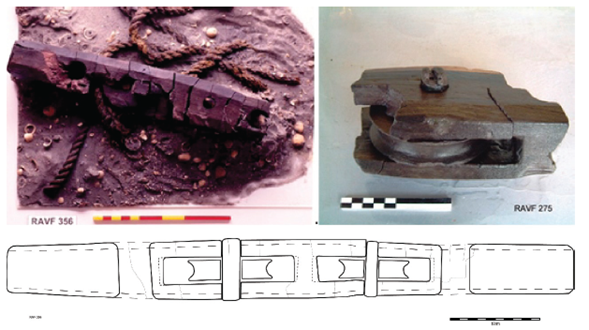
Source: Photographs and drawing from the CNANS archives.
Figure 18 RAVF 356 tackle block and the respective drawing (bottom); RAVF 275
The best-preserved wooden artefact is a complete subcylindrical block, with a hole for a circular sheave (Fig. 19). It is more robust than the other pieces, measuring 33.2 cm in length and 15.7 cm in width. In a longitudinal perspective, it features scores on both sides, to accommodate the strap that would attach it to another part of the rigging. This piece has clear parallels in the sampless found in the Mary Rose (Marsden, 2009, p.264).
A 29 cm long, 10.5 cm wide and 4 cm thick piece, corresponding to a fairlead, was also recovered (Fig. 20). It has two square nails measuring 0.5 cm to the side, which cross its entire width and a 7 cm long and 3.5 cm wide/high notch showing cut marks. Parallels for this sample can be found on the La Belle (1686) (Corder, 2007, p.261) and Natière I ships (France, La Dauphine, 1704) (L'Hour and Veyrat, 2001, p.104).
The RAVF fittings are important for the analysis of the chronology of the archaeological site, since the known parallels would ultimately suggest an affiliation to the 16th century, distancing it from the more recent models. In fact, somewhere between the end of the 16th century and the middle of the 17th century there was a formal change in the fittings, only scarcely studied so far (Sanders, 2009, p.19). For example, the deadeyes gradually lose their drop-like shape and become biconvex, while the blocks lose their rounded shape at the bottom. It is possible to observe this evolution because in ships from the second half of the 16th century the deadeyes are still drop-like, but in the Vasa (1628) (Bengtsson, 1975, p.34), in the Kronan (1676) (Einarsson, 1990, p.293) or in the La Belle (Corder, 2007, p.231-242) they already have a biconvex shape (Lopes, 2013, p.55).
The study of the rigging (Fig. 21) followed Sanders (2009) methodological proposal. Among the 81 analysed cable remains, there are 48 three-strand cables, 28 two-strand spun yarns, one warp-laid rope and four four-strand cables. Seventy fragments were Z-twisted and 11 were S-twisted. The average gauges of the cables and ropes are the following: three-strand, 2,1 cm; two-strand spun yarns, 1,6 cm; warp-laid rope 4.6 cm; four-strand, 3 cm. The average gauges of the strands is 1.1 cm, yarns 0,5 cm and fibers 2 mm. Out of the 28 identified yarns, 19 were Z-twisted and 9 were S-twisted, while in the case of the fibers 68 were Z-twisted and 11 were S-twisted.
A bolt rope was also identified (Fig. 22); it was normally used in the edges of sails, hand sewn using a four-strand rope with a 2.9 cm gauge. This pattern (Esparteiro, 1975, p.27) was found in various contexts, namely the Vasa (1628) (Bengtsson, 1975, p.35) and the Swedish ship Jeanne-Élisabeth (1755) (Sanders, 2011, p.75).
Other findings
Among the materials related to the ship there are ballast stones, from which 51 samples were recovered (Fig. 23). The vast majority is limestone (61%), followed by graywacke (22%), basalt (6%) and granites, quartzites and limestone breccia (ca. 4% each). The ballast was completely dispersed throughout the archaeological site, probably resulting from the dredging works. All the rocks identified among the ballast exist in the geological formations of the upper Jurassic and Cretaceous known in the Portuguese territory and continental shelf. The light-coloured limestones and the basalts seem to match similar rock types from the Estremadura region, more specifically from the Lisbon area, while the dark limestones can be found in the Cabo Mondego region. The limestone breccia shows features typical of the Serra da Arrábida, which is a good indicator because this is a type of rock that only exists in this particular area, as far as the Portuguese territory is concerned (Lopes, 2013, p.65-67).
The 19 pottery shards found are uncharacteristic and were scattered throughout the archaeological site. All are made of red clay and the majority show a black patina and are quite degraded. The pastes are compact, homogeneous, with fine to coarse grain non-plastic elements, namely quartz, feldspar and mica, and their colour ranges from orange to red. A reddish engobe was applied to some exemplars. Finally, the black patina observed on the overwhelming majority of the shards may correspond to remnants of some product transported in these containers or an indication that these items were burned, either due to their use in cooking or to some fire that may have occurred aboard the ship. Their analysis contributed little to the study of the overall context, since no conclusions have been reached as to their origins or typology.
The limestone cannonball has a diameter of 11 cm and a weight of 901 grams (Fig. 24). Parallels for this projectile, with matching dimensions and raw material, can be found in the mid-15th century Newport ship (Jones & Stone, 2018, p.29), the mid-16th century Cattewater ship (Redknap, 1984, p.88) and the Mary Rose (Hildred, 2011, p.342). As a rule, cannonballs of this calibre were used in falconets and this particular one seems to be finished, i.e. it was chiselled in in order to be used without any problem in the artillery piece (Hildred, 2011, p.344).
Chronology, origin and operation of the vessels
One of the key issues in this archaeological context is its dating. The 2 sigma calibration of two C14 dating indicates a chronology between the end of the 13th century and the middle of the 15th century (Table 2). However, the samples submitted to analysis were taken from structurally isolated pieces, which were found in the preliminary surface survey. Therefore, no elements belonging to the main clusters of this context and still in connection were analysed.
Table 2 Radiocarbon dates obtained for RAVF samples and their respective 2 sigma calibration
| Site | Sample | Material | 14C age yr BP | 95% (2 sigma) age cal AD |
|---|---|---|---|---|
| RAV F | Beta - 166381 | Wood - Gunwale pole, clinker hull | 510±50 | 1320 a 1350; 1390 a 1460 |
| RAV F | Beta - 165222 | Wood - Y-shaped frame, carvel hull | 620±60 | 1280 a 1420 |
The dating obtained through the study of archaeological structures and materials indicates the 16th century. Clear parallels for the fittings can be found in mid-16th century ships and the stone cannonball is identical to those used in ships during the late 1400s and early 1500s. Some construction details of the carvel-built ship, such as the shape of the frame's scarves and the fact that the planking is attached to the frames mostly using iron fastenings have parallels in medieval and Renaissance ships of Mediterranean origin. However, there are also some characteristics that fit into the influence of the Iberian Peninsula during the 16th and 17th centuries, such as the keelson fitted onto the upper face of the floor timbers or the mast step is an expanded portion of the keelson (Oertling, 2001, p.236). At the same time there is the question of the use of a stern as a connecting element between the keel and the sternpost, which appears both in Mediterranean and Atlantic ships.
We would stress the fact that vessels with these characteristics could indeed sail the Atlantic and their use in the sugar trade between Portuguese and Brazilian ports is documented between the middle of the 16th century and the middle of the 17th century (Costa, 2002, p.183-184). The issue of ocean navigation using small/medium sized ships is not a much debated subject, although there are some cases that seem to prove it, such as the Angra F ship (Angra do Heroísmo, Azores) (Bettencourt, 2018, p.556-557).
Another element that concurs to the dating issues, but also to the operation of the vessel, is the origin of the timbers. It was not possible to specifically identify the species to which the fragments analysed by dendrochronology belonged, but written documentation attests to the use of wood from the same families in shipbuilding and repair in Brazil during the 16th century (Lopes, 2013, p.79). Thus, the genus Nectranda identified in a fragment of the clinker planking was in fact used as a raw material for this specific part of the vessels (Hutter, 1985, p.423). Licaria was also used for stringers or longitudinal reinforcement parts, Ocotea for parts with more curved shapes and Myristicaceae for the production of oars (Hutter, 1985, p.420-426). Moreover, there are references to the existence of colonial shipyards from the middle of the 16th century onwards, and it is likely that not only ship repair and support works but also the construction of India Run ships and smaller vessels were already carried out before (Lapa, 2000, p.51-52); this would include RAVF. There were several shipyards along the coast of Brazil (Pernambuco, Rio de Janeiro and São Vicente), to which some Portuguese vessels resorted (Lapa, 2000, p.51-52; Mauro, 1997, p.73-81). It is therefore not unlikely that the identification of American species, particularly from the present-day territory of Brazil, on the clinker hull support vessel reflects the activity of these shipyards. Hence, the chronology of this vessel necessarily postdates the beginning of the 16th century.
With regard to the possible port of origin, Aveiro, we would point out that while salt production was its economic activity par excellence from the 13th century onwards, due to the decline of northern European navies resulting from the colder period recorded at the time, other activities were decisive for its development, such as fishing, shipbuilding, milling and pottery (Branco, 1991, p.44; p.107-109; Amorim, 2001, p.5; Bastos, 2004, p.140). From the 16th century onwards, Aveiro started to be a well-established pottery centre, a fact widely supported by archaeological evidence over the last two decades. The massive presence of ceramics from this region is well documented in central and northern Portugal, and generically in northwestern Iberia. The same can be said of its occasional appearance in various points of the northern coasts of Europe and more so in the Atlantic islands of Azores, Madeira, the Canaries and Cape Verde and, finally, in more specific occurrences on the coasts of North America (Florida and Newfoundland) and in Brazil. Aveiro has made a name for itself in the production of sugar moulds and their export to the Atlantic production centres (Bettencourt & Carvalho, 2008, p.276-277; Coelho, 2009, p.179-181). In this period, Brazil was rising as a territory with grand potential in this production, and sugar cane mills were being settled along the coast (Johnson, 1992, p.242-243). Thus, it is not hard to think that the RAVF carvel hull was one of the vessels sailing the Atlantic out of Aveiro during the early stages of the sugar economy and that a support/transhipment vessel was acquired on one of its voyages to the New World.
Conclusions
The results of the RAVF study indicate a carvel-built vessel constructed according to Mediterranean techniques, as the hook scarves and the fastening system is almost entirely composed of iron nails. These architectural features have been observed in 14th-17th century ships from the Mediterranean area. At the same time, some other characteristics match the 16th and 17th-century Ibero-Atlantic tradition, such as the keelson being fitted to the top surface of the frames, the mast step sitting on the expansion of the keelson and the teardrop-shaped deadeyes. In fact, the analysis of the fittings is particularly important for the discussion of the ship's chronology, because the deadeyes, the heart block, the tackle blocks and the blocks are identical to those found on mid-16th century ships. In the end we have to point out the fact of stern being used as a joint between the keel and the sternpost is a feature common both in de Mediterranean and in the Atlantic, which does not allow us with certainty connecting the RAVF wreck with a shipbuilding tradition in particular.
The remains of the clinker-built vessel are few and severely eroded, but they arguably correspond to a logistical support or transhipment vessel (like a boat or skiff), built from scratch using tropical American woods, possibly from Brazil.
The main ship was therefore a small carvel-built ship, arguably sailing the 16th-century Atlantic shipping routes. Its port of origin was possibly Aveiro and on one of its voyages to America, a small clinker-built support boat, manufactured in some local shipyard, was acquired. In short, this archaeological site is composed of two vessels that are just one example of the vast array of ships that have called at the lagoon of Aveiro over the centuries and have boosted the city as an important harbour for trans-oceanic shipping routes. We hope to continue this study in the near future with new approaches and other scientific analyses that may contribute to new perspectives on the RAVF site.
This article had the support of CHAM (NOVA FCSH / UAc), through the strategic project sponsored by FCT (UID/HIS/04666/2019).













